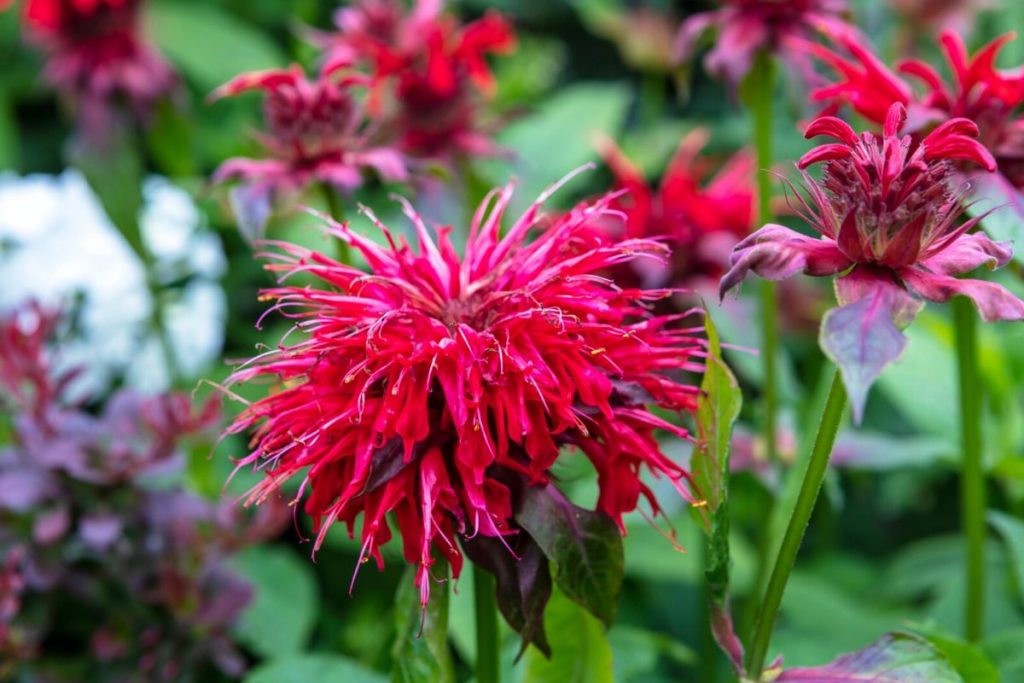A garden full of colors sure does wonders! You can never go wrong with lively and showy blooms that make your place more pleasing to the eyes. One ornamental plant that helps brighten a garden with its vivid and attractive flowers is bee balm.
Bee balm, otherwise known as wild bergamot or Monarda, is an outstanding flowering perennial commonly used in flower beds or pollinator gardens for its picturesque and charming whorled blooms of red, purple, white, or pink. Its equally attractive foliage emits an evocative fragrance that adds value to its overall desirability.
Often overlooked, this impressive member of the mint family offers versatility in any perennial garden. Learn more about bee balms with this comprehensive guide.
Bee Balm Facts
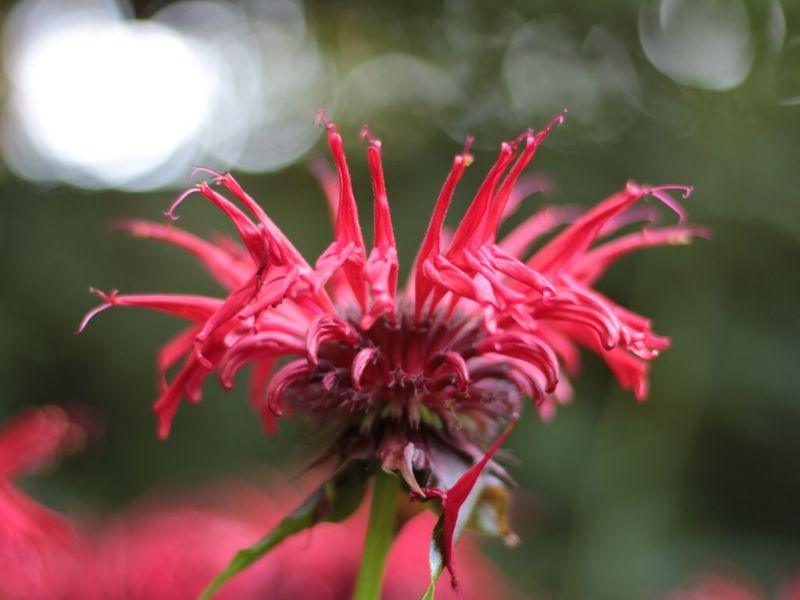
Name and Origin of Bee Balms
Bee balms, which are native to eastern North America (1), are a member of the Mint (Lamiaceae) family. The name “bee balm” is one of the many common names of the Monarda genus. Other known names of this plant are Monarda, wild bergamot, horsemint, and Oswego tea.
The genus Monarda is named after Nicolás Bautista Monardes, a famed Spanish physician and botanist who wrote several books about plant life and medicine. One of his books is the first medicinal flora of North America, which was translated in 1577 from its original title Joyfull Newes Out of the Newe Founde Worlde.
The common name bee balm is a reference to one of the many uses of this famed plant. The plant produces a resin, which is used to soothe bee stings. The common name Oswego tea, on the other hand, originated when the Oswego Indians use this plant’s leaves as tea (1).
Bee balms have a distinct aroma that quickly reminds anyone of the citrus scent of bergamot fruits (Citrus bergamia), hence the common name wild bergamot. Note, however, that bee balms are entirely different from the citrus bergamot plant.
Uses
Medicinal and Edible Uses
The foliage of bee balms has long been used as a disinfectant in traditional medicine, particularly by Native Americans. Bee balms are also commonly used against cold and flu.
Also called Oswego tea, bee balm leaves are dried and often served as a tea to improve digestion or aid in headaches and fevers. It also helps against flatulence, nausea, cramps, and vomiting (2).
Also, aboveground parts of bee balms are edible, acknowledging that they are part of the mint family. These plants, particularly the leaves and flowers, are often added in salads, beverages, or pork recipes (2). Bee balm leaves and flowers, in addition, are utilized as flavorings in cooking. The resin helps soothe bee stings (1).
Garden and Landscape Uses
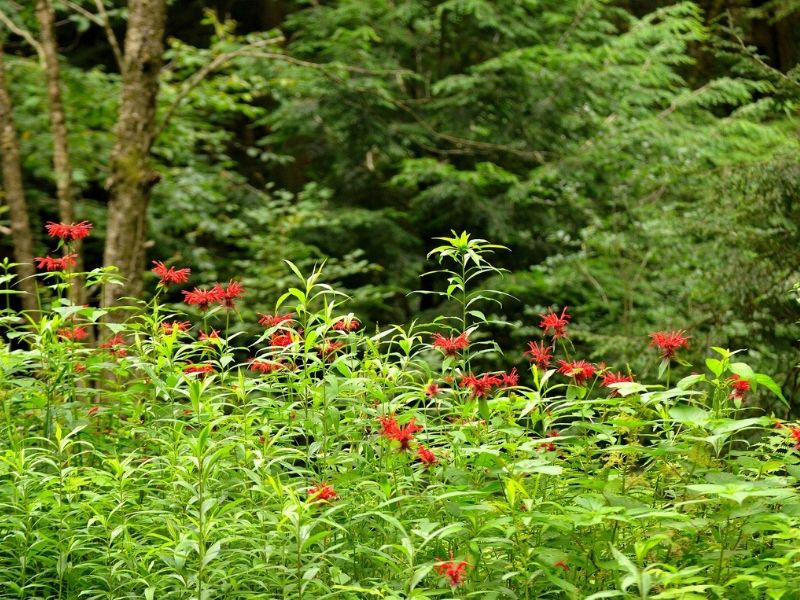
Bee balms are ideal as border plants in gardens. This beautiful perennial attracts butterflies, bees, and hummingbirds with its colorful and exotic blooms. The vivid flowers give the right contrast to brighten any area in butterfly and bee gardens (1).
Some bee balm varieties are small and compact. Called dwarf bee balms, they make excellent ornamental plants in pots or containers.
General Description and Characteristics
Bee balms are perennial herbs that grow approximately about 2 to 3 feet in height upon full maturity (2). They are non-toxic and edible, with a medium growth rate and a clumping type of growth habit (1).
Bee Balm Flowers
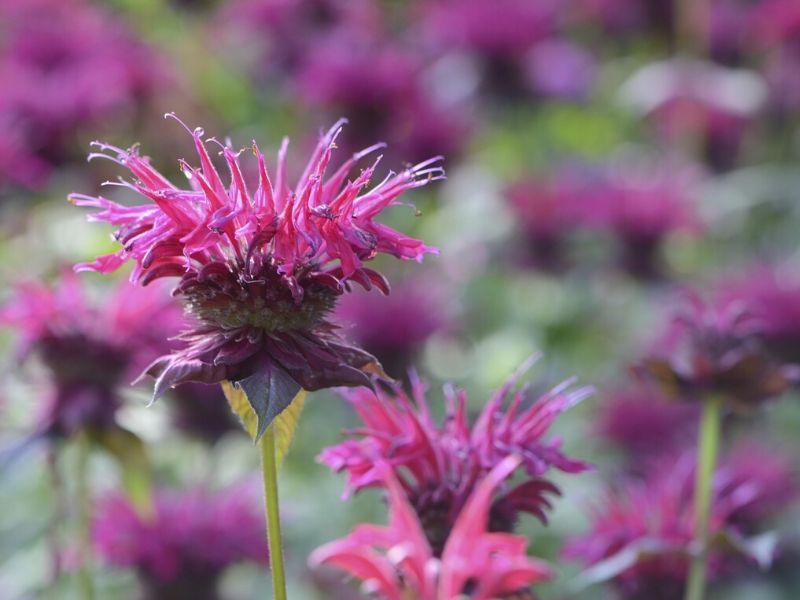
Bee balm flowers usually come in either red or purple (2), but some varieties produce other colors such as golden yellow, pink, and white. They are one of the best flowers to plant in your garden.
A single, dense, and globular flowerhead is formed at the end of the stems or axils. Each flower head is about 3 to 4 inches in size with leaf-like bracts underneath. The upper bracts are short and wide, while the lower bracts are ovate or lanceolate in shape.
Each flower is about 1.5 inches long and comprised of a two-lipped corolla and a tubular calyx. The upper corolla lip, which has soft hairs on the outer surface, is tubular in shape and semi-erect. The lower corolla lip, on the other hand, is narrow in shape and arches downwards. The outer rim of the tubular calyx features five teeth (1).
The flowers bloom in early to mid-summer, which lasts up to 8 weeks. Bee balm flowers are not scented.
Bee Balm Leaves
The leaves of bee balm plants are long and narrow (2). They are arranged oppositely on a hairy square stem. Most bee balm leaves are ovate to ovate-lanceolate in shape and medium to deep green in color. Individual leaf measures about 3 to 6 inches long (1) and 2 inches across. The leaf surface is slightly hairy with serrated edges.
Bee balm leaves are fragrant and ooze with a mint-like scent. Like the flowers, the leaves are edible.
Bee Balm Stems
Bee balm stems are square (four-angled) and feature small, soft hairs. They are rigid and grooved. They often grow about 3 ft high. Some varieties require staking, but most do not.
Bee Balm Roots
Bee balms grow and spread by rhizomes. The rhizomes spread underground and produce new shoots.

Recommended Bee Balm Varieties
The genus Monarda includes 18 known species and 17 accepted taxa (3). It has countless of cultivars available, but the most popular ones fall under the Monarda didyma. Compiled below are some of the best bee balms for ornamental use.
Monarda didyma ‘Beauty of Cobham’
Monarda didyma ‘Beauty of Cobham’ is one of the most popular cultivars of bee balms. In fact, it gained the Royal Horticultural Society’s (RHS) Award of Garden Merit (AGM). The ‘Beauty of Cobham’ cultivar features scented green lanceolate leaves with a purple tinge, and light, soft-looking lilac-pink blossoms. This herbaceous perennial grows about 2 to 3 ft in height and spreads up 1 to 2 ft.
This Monarda cultivar is more resistant to powdery mildew disease than other varieties.
Monarda fistulosa ‘Claire Grace’
Monarda fistulosa ‘Claire Grace’, otherwise called Monarda ‘Claire Grace’ or Claire Grace bee balm is a herbaceous perennial that grows about 3 to 4 ft and spreads about 2 to 3 ft at full maturity. This M. fistulosa variety tolerates both wet and dry soil conditions. It also has a high tolerance to powdery mildew.
The name ‘Claire Grace’ is a tribute to the daughter of Barb and Michael Bridges of Southern Perennial and Herbs, who both discovered the plant in Mississippi.
Extremely showy, the plant flaunts purple-pink flowers that attract butterflies, hummingbirds, and bees. The scented leaves are toothed, oblong, and grayish-green.
‘Claire Grace’ bee balms bloom in early summer to early fall.
Monarda didyma ‘Dark Ponticum’
The ‘Dark Ponticum’ cultivar of bee balms is known for its pure purple to violet blooms that give an instant pop of color to gardens. However, the flowers are not the only plant part that makes this cultivar attractive. It also presents blue-green foliage that makes it even more appealing all season long.
This M. didyma variety is another powdery mildew-resistant bee balm. It is regarded as one of the best performing native Monardas, especially once fully established.
Monarda didyma ‘Gardenview Scarlet’
Award-winning and truly stunning, the Monarda didyma ‘Gardenview Scarlet’ or simply referred to as Bee Balm ‘Gardenview Scarlet’ flaunts true red blooms that measure about 4 inches each. This clump-forming perennial is known as one of the top performer varieties of bee balm plants.
It blooms for weeks from mid-summer to early fall. Each plant reaches up to 3 to 4 ft tall and spreads up to 2 to 3 ft.
Monarda didyma ‘Jacob Cline’
The ‘Jacob Cline’ variety is one of the best known red bee balms. It is recognized for its enormous, vivid red blooms that sit atop a whorl of dark purple bracts. Complementing the attractive flowers are dark green leaves that emit a fragrant scent. Like other varieties mentioned above, the ‘Jacob Cline’ Monardas are resistant to mildew diseases.
This bee balm variety grows about 3 to 4 feet tall upon full maturity. It spreads up to 2 ft.
Monarda ‘Squaw’
The award-winning Monarda ‘Squaw’ is known for its vigorous growth and bright scarlet red flowers. It grows in clumps and reaches 3 to 4 ft in height and spreads up to 2 ft. It also flaunts aromatic, bright green leaves. The blooming period for Squaw bee balms lasts for weeks from mid or late summer to fall.
Bee balm ‘Squaw’ is a recipient of the Royal Horticultural Society’s Award of Garden Merit. The prestigious award is given to garden plants with outstanding performance under UK growing conditions.
Monarda ‘Petite Delight’
Perhaps the most popular bee balm cultivar that boasts the brightest pink flowers possible is the Monarda ‘Petite Delight’. The leaves are fragrant, shiny, and dark green. Also known as horsemint bergamot or dwarf bee balm, this bee balm grows best if planted under partial to full shade and in moist soil.
The ‘Petite Delight’ bee balm is a compact variety that grows only about 1 to 1.5 ft in height and spreads up to 2 ft, hence the name. Because of its size, these potted bee balm plants variety makes an excellent front border plant or edging plant. It is also used in containers.
Monarda didyma ‘Purple Rooster’
A summer blooming variety, the Monarda didyma ‘Purple Rooster’ displays amazing masses of big royal purple flowers and delightfully fragrant green foliage. The plant reaches 2 to 3 ft in height upon full maturity, with a spread of 1 to 2 ft. Flowers grow about 3 inches across.
Aside from its extraordinary aesthetics, Purple Rooster bee balms are highly tolerant of powdery mildew disease. In addition, the stems are rigid and robust such that they never required staking despite their tall height.
The name ‘Purple Rooster’ is given by the owners of The Flower Factory Nursery, Inc., David and Nancy Nedveck after the former’s love for roosters.
Monarda ‘Judith’s Fancy Fuchsia’
Also called as Judith’s bee balm, the Monarda ‘Judith’s Fancy Fuschia’ cultivar flaunts large, vibrant fuschia pink blooms and aromatic green leaves. This upright clumping perennial showcases floriferous blooms in mid-summer to late summer for at least six weeks. Flowers measure about 3 inches in size.
The Judith’s Fancy Fuschia bee balms typically grow up to 3 ft in height and spread about 2 ft. They have superior resistance to powdery mildew disease than most bee balm cultivars.
Monarda didyma ‘Grand Marshall’
Monarda ‘Grand Marshall’ or also known as Monarda ‘AChall’ is one of the top performers of bee balm varieties. It was introduced by the Agriculture and Agri-Food Canada Research Station through its breeding program in Morden, Manitoba.
This bee balm showcases captivating heads of large deep pink to purple flowers that bloom in mid-summer to late summer for weeks. A compact variety, Grand Marshall bee balms grow about 1.5 ft in height and spread up to more or less 2 ft. Like other top performer bee balm cultivars, the Grand Marshall offers high resistance to powdery mildew.
Culture, Care, and Maintenance
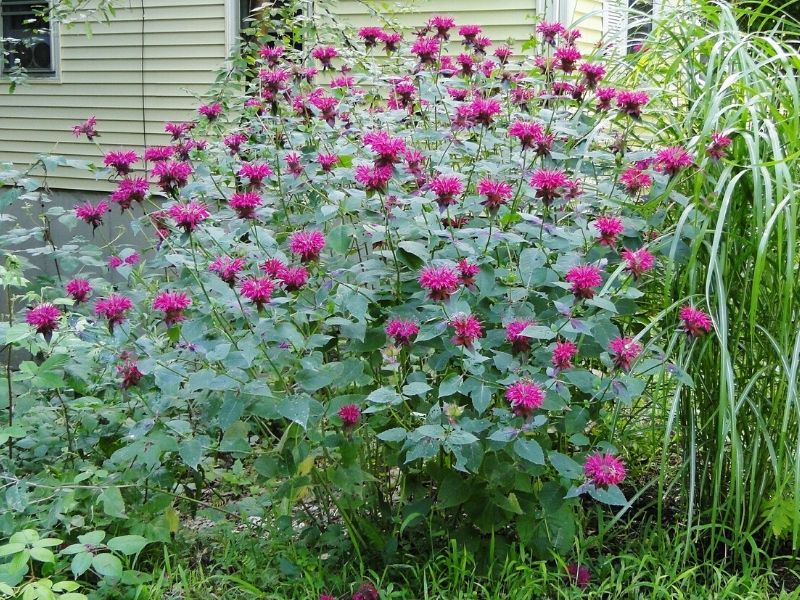
How To Grow Bee Balm Plant
Bee balms are perennials that make an excellent addition to pollinator gardens since they attract plant pollinators like bees, butterflies, and hummingbirds. The beautiful and colorful blooms of these plants further suit flower beds in any garden.
Generally, bee balms are easy to grow as long as proper planting conditions and care are given.
Plant Bee Balm
These plants thrive best under full sun and moist, well-drained soil. Though bee balms tolerate partial shade, flowering can be scarce, and the plants can be more susceptible to powdery mildew (4). Planting bee balm should be made in spring or fall, with a planting space of 18 to 24 inches between plants. Proper spacing is essential to ensure sufficient airflow and reduced occurrence of powdery mildew infestation (6).
Watering
Since bee balms prefer moisture during their entire growing season, watering every 7 to 10 days is advised to gain optimum performance.
Fertilizing
Bee balms do not require regular fertilization. Avoid over-application of fertilizers as much as possible. Since bee balms grow from rhizomes, they tend to get aggressive (or, in some cases, invasive), and over-fertilizing may promote unnecessary rampant growth. A small amount of all-purpose fertilizer like 10-10-10 around each plant is sufficient enough (4).
Division
The division of plants prevents overcrowding. Large clumps must be divided every 2 to 3 years in early spring to keep their optimum performance (5). Divide the clumps into sections of 2 to 3 shoots with a good root system, then replant promptly (4).
Deadheading
Deadheading prolongs flowering. Remove spent flower heads to lengthen the blooming period (4).
Repotting
Bee balm can be successfully repotted to ensure its continued health and vigor. Spring or fall is the best time for repotting bee balm. Choose a well-draining container with good drainage holes, and use moist, fertile soil with organic matter.
Regular watering is crucial, especially during the first year. Proper repotting ensures healthy bee balm growth and vibrant blooms.
Bee Balm Pests
One of the most common insect pests of bee balms is stalk borers. Stalk borer larvae damage bee balm plants by feeding on the tender tissue of the stem, which results in wilting. Symptoms of stalk borer infestation include small holes in the stem that are surrounded by powdery yellow debris called frass. Infected plants must be destroyed immediately to avoid further damages to other plants.
Bee Balm Diseases
The most common disease problem associated with bee balms is a fungal disease called powdery mildew. Although most of the popular varieties are resistant to this fungal disease, others are still susceptible.
Bee balms with poor air circulation and thick foliage are often infected with powdery mildew (5). Symptoms include grayish white patches of powder on the upper surfaces of the leaves. When leaves are severely affected, they drop prematurely.
Aside from choosing varieties that are resistant to powdery mildew, doing proper cultural practices is the next best option to reduce the severity of disease infection. It is best to plant bee balms under full sun with adequate spacing (4).
The division of large clumps should be made every 2 to 3 years to avoid overcrowding and poor air circulation between plants. Immediately remove any infected plant or plant part and destroy any debris in the fall (4).
Toxicity
Bee balm plants are not toxic or poisonous. They are edible and often used in drinks or salads, and as food ingredients.
If you worry about your pets or small children accidentally ingesting poisonous plants in your home garden, then bee balms are one of your best options to plant. It’s one thing that these perennials give instant color and fragrance to boost your beautiful home, but the fact that they are also pet-friendly and kid-friendly is another.
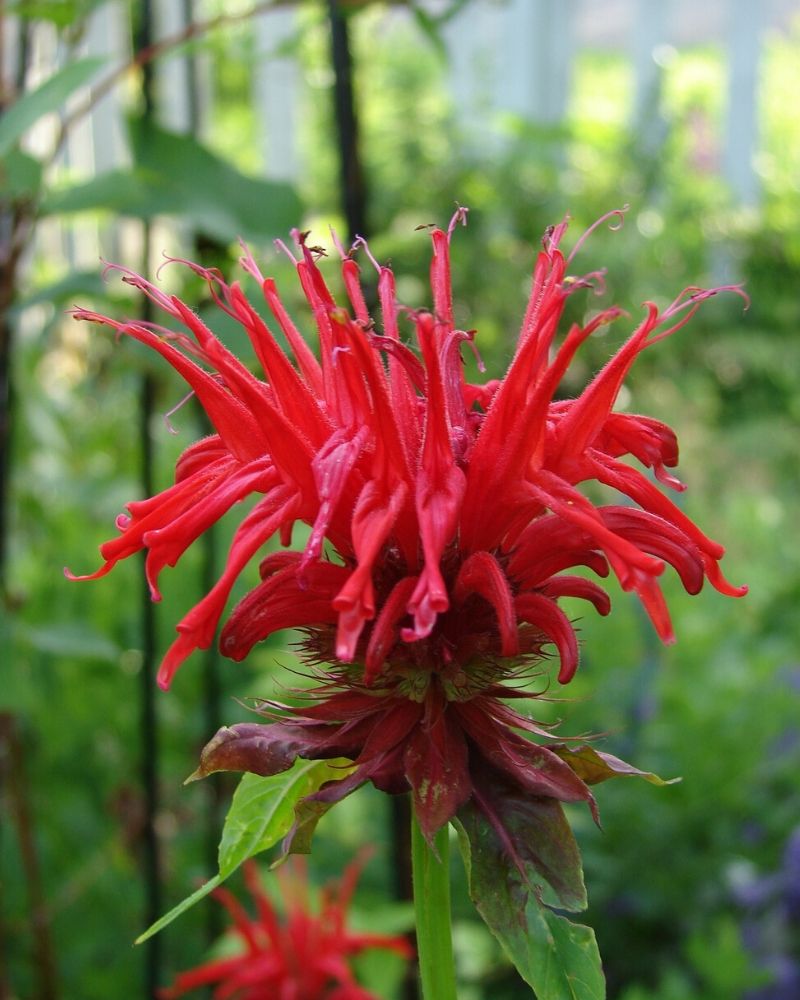
What Does Bee Balm Flower Represent?
Monarda, or more commonly known as bee balm, generally symbolizes wealth and prosperity. But with its different flower colors, symbolism and meaning of bee balm flowers also vary.
The plant shares a rich history in traditional medicine. It has been highly valued for a long time for its medicinal uses. Because of this importance, bee balms often symbolize good health and protection against illnesses.
For some, bee balms signify fertility and promote restful sleep.
FAQs
Does bee balm need to be cut back?
Yes, bee balm (Monarda) benefits from regular pruning to encourage bushier growth and prolong flowering. Prune back spent flower heads and trim back stems in early spring to promote new growth.
Does bee balm spread?
Yes, Bee balm can spread via rhizomes or self-seeding, especially in favorable growing conditions. Regular division of clumps and deadheading spent flowers can help control its spread.
What to do with bee balm after it blooms?
After bee balm blooms, deadhead spent flowers to encourage reblooming and prevent self-seeding. Additionally, consider cutting back stems to promote bushier growth and prolong flowering.
What are common problems with bee balm?
Common problems with bee balm include powdery mildew, root rot, and pests such as aphids or spider mites. Providing good air circulation, avoiding overhead watering, and promptly addressing pest or disease issues can help prevent problems.
How do you keep bee balm blooming all summer?
To keep bee balm blooming all summer, provide it with full sun to partial shade and consistent moisture. Deadhead spent flowers regularly, apply a balanced fertilizer in early spring, and provide adequate airflow to prevent powdery mildew.
Did you find this article helpful? Then check out our article on perennial plants and flowers for more information about flowers similar to bee balms.
Up next: What to plant with bee balm
References
Reference List:
- Plants.ces.ncsu.edu. (2020). Monarda didyma (Beebalm, Bee Balm, Bee-balm, Bergamont, Bergamot, Crimson Bee-balm, Horsemint, Oswego Tea) | North Carolina Extension Gardener Plant Toolbox. [online] Available at: https://plants.ces.ncsu.edu/plants/monarda-didyma/
- Webstu.onu.edu. (2020). Monarda didyma L: Bee Balm, Scarlet Bee Balm, Bergamot, Fragrant Balm, Mountain-mint, or Oswego-tea | The Medicinal Herb Gardens at ONU. [online] Available at: https://webstu.onu.edu/garden/node/309
- Plants.usda.gov. (2020). Classification | USDA PLANTS. [online] Available at: https://plants.usda.gov/java/ClassificationServlet?source=display&classid=MONAR
- Hortnews.extension.iastate.edu. (2020). Growing Bee Balms in the Home Garden | Horticulture and Home Pest News. [online] Available at: https://hortnews.extension.iastate.edu/2006/4-5/beebalm.html
- Plants.usda.gov. (2020). [online] Available at: https://plants.usda.gov/plantguide/pdf/cs_mofi.pdf
- Plants.usda.gov. (2020). [online] Available at: https://plants.usda.gov/plantguide/pdf/pg_modi.pdf
Close
*Photo by Debu55y – depositphotos

